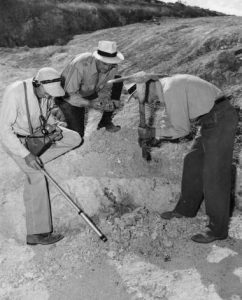Jeffrey D. Nichols
History Blazer, December 1996

Uranium prospectors with pick and Geiger counter
The history of much of the American West has been marked by boom and bust cycles. Perhaps the most famous example is the California gold rush, which brought tens of thousands of Forty-Niners to the Golden State, a tiny fraction of whom ever struck it rich. Southeastern Utah has experienced a number of boom and bust cycles with one of its most famous products—uranium.
Uranium ore was known to some of the earliest inhabitants of the region around Moab. Native Americans used the substance to create red and yellow paints for ceremonial decoration. In the 1870s prospectors mined the material and sent most of it to Germany and France where it was turned into industrial dyes for the ceramics industry. In 1898 Marie Curie discovered radium in uranium, and another market for Utah’s ore emerged. When a process for separating radium from uranium ore was perfected in 1913, uranium mining boomed. Radium seemed to have no end of uses; it was promoted as a wonder drug and became an ingredient in bath salt, salves, and therapeutic muds. During World War I radium was used to illuminate watch faces, gunsights, and compasses.
While the war’s disruption of international trade dampened the uranium boom, the need for vanadium, another component of uranium ore, helped pick up the slack. Vanadium was useful for increasing the strength of steel, which of course was in great demand for the war effort. The end of the war brought recession, however, and in 1923 an even greater blow struck Utah’s uranium industry. Immense pitchblende deposits rich in radium were discovered in the Belgian Congo (present Zaire), and the market for Utah’s radium dried up.
For a time, the demand for vanadium helped keep the boom alive in the 1920s. Then the discovery of more easily accessible deposits in Peru caused prices to plunge. Uranium mining continued at a lower level. Prospectors like Howard Balsley, who bought ore from many other small producers, in turn sold it for mineral pigments, ceramic colorant, and its vanadium content in the 1930s. World War II brought another great demand for vanadium, but in 1944 the government announced that it was overstocked and stopped purchasing ore for its vanadium content.
In 1945 another use for uranium ore would emerge. The successful completion of the Manhattan Project created a new and vastly more destructive class of weapons. Cold War tensions between the United States and the Soviet Union launched an unprecedented arms race with atomic bombs as the most prized (and feared) weapons in each nation’s arsenal. The Atomic Energy Commission was initially convinced that the West could not supply the nation’s uranium needs but exploratory surveys in the early 1950s changed their minds. In the summer of 1952 a geologist named Charles A. Steen found the massive Mi Vida deposit in the Big Indian District near Moab. The latest boom was on.
Geologists, prospectors, and mining engineers poured into Utah. Moab became their headquarters, and the town’s population quintupled. Salt Lake City became the financial center for the boom, with issuance of penny uranium stocks and widespread speculation. Then in 1956, the AEC announced that its stocks of uranium were plentiful. Like the radium and vanadium booms before it, the latest uranium boom was largely over. Uranium mining continued at a much more sedate pace, taking its place among other southeastern Utah industries.
Sources: Grand Memories (Grand County, Utah: Daughters of Utah Pioneers, 1972); Richard E. Westwood, “Howard W. Balsley, Dean of Uranium Miners and Civic Leader of Moab,” Utah Historical Quarterly 59 (Fall 1991); Don Sorensen, “Wonder Mineral: Utah’s Uranium,” Utah Historical Quarterly 31 (Summer 1963).
